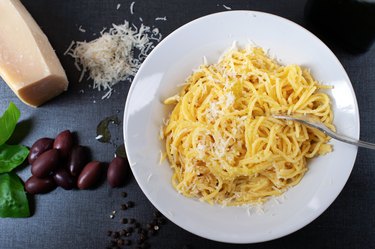
Pasta is a major comfort food, but unfortunately, white pasta nutrition leaves something to be desired. It's not just about the calories in pasta, though. Many commercial varieties of pasta are loaded with simple carbohydrates and stripped of other important nutrients that make up a healthy meal.
While the nutrition of pasta is similar across the board, the exact number of calories in your bowl depends on what type of pasta you choose, the number of servings you have and what type of sauce you finish your meal with.
Video of the Day
Video of the Day
Calories in Pasta
The exact amount of calories in a bowl of pasta depends on which type of pasta you choose, but for the most part, 1 cup of cooked pasta will fall somewhere in between 160 and 200 calories, according to USDA FoodData Central. If you go for a cup of spaghetti, calories clock in at 196 (with 2.2 grams of fiber), but if you opt for penne, you'll get 169 calories (and 1.9 grams of fiber) per cup.
If you choose whole wheat pasta instead of instead of white noodles, calories don't change much, but you will be getting significantly more fiber. The same cup of whole wheat spaghetti will provide you with 174 calories, but 4.6 grams of fiber. Choose a cup of whole wheat penne instead and you'll be at 145 calories and 3.8 grams of fiber.
Keep in mind these calorie counts are for a whole cup of pasta, which is actually considered two servings, although it's a common portion size. If you're eating out at a restaurant, it's likely that you're getting even more than a cup of pasta in your bowl. If you're eating at home, measure out each serving of pasta as you add it to your bowl to ensure you're staying where you want to be calorie-wise.
Of course, it's unlikely that you're eating your pasta plain, so you also have to consider the sauce or toppings that you're adding when trying to figure out your calories. A half-cup of regular marinara sauce will add only 66 calories, while the same amount of the creamier, and heavier, Alfredo sauce contributes 220 calories.
Calories in Rice
If you're looking for a different type of grain to replace the pasta in your bowl, you can opt for rice instead. While you might not save on much in terms of calories, rice is gluten-free and, unlike white pasta, which spikes blood sugar, it may also help balance blood sugar and improve glycemic control, according to a May 2017 report in Nutrition and Diabetes.
A cup of cooked white rice contains 205 calories, while the calories in cooked brown rice clocks in at 239 per cup — only slightly higher. Of course, if you're trying to cut down on calories, you don't have to eat a whole cup. In fact, as with pasta, a typical serving of rice is actually 1/2 cup, according to the American Heart Association. This means that if you stick to the proper serving size, you're looking at adding around 100 additional calories to your meal.
- Nutrition and Diabetes: "Eating Glutinous Brown Rice Twice a Day for 8 Weeks Improves Glycemic Control in Japanese Patients With Diabetes Mellitus"
- USDA FoodData Central: "Sauce, Pasta, Spaghetti/Marinara, Ready-To-Serve"
- USDA FoodData Central: "Alfredo Sauce"
- USDA FoodData Central: "Pasta, Cooked, Enriched, Without Added Salt"
- USDA FoodData Central: "Pasta, Whole-Wheat, Cooked"
- American Heart Association: "What Is a Serving?"
- USDA FoodData Central: "Rice, White, Long-Grain, Regular, Enriched, Cooked"
- USDA FoodData Central: "Brown Rice"
Was this article helpful?
150 Characters Max
0/150
Thank you for sharing!
Thank you for your feedback!